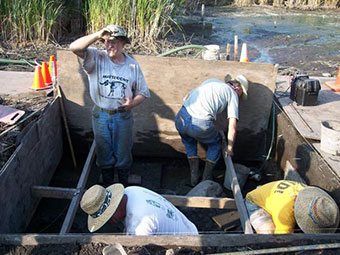Digging For Mastodons
by Jack Foran

Feel like getting dirty? Volunteer with the Buffalo Museum of Science
Here’s a summer job opportunity for long hours (a 12-hour day), hard work (digging and such, and be ready to get dirty), and no pay (self-explanatory).
And the opportunity part? The opportunity to make a material contribution to the archeological and paleontological record of the Western New York region. Not to mention, learn a ton in the process.
The job is volunteer work on the Buffalo Museum of Science mastodon dig at the Hiscock Site in Byron, New York, near Batavia.
It’s a fascinating site. The earliest findings are from the end of the last ice age, when mastodons roamed the area, just before they became extinct. Which is also about when humans began to inhabit the area. One theory—which is not universally accepted—is that human hunting activities caused the extinction of the mastodons.
The findings include plentiful mastodon evidence, and evidence of what happened after the extinction of that species, in particular, the colonization of the territory by smaller mammals, such as deer and rodents, and a huge variety of birds. As well as evidence of human habitation, from ice age Clovis point chipped flints to shard ceramics dating to the early 1800s.
As Dr. Richard Laub of the museum, who runs the project, puts it, “The Hiscock site documents the changing faunas, floras, cultures, and environments of Western New York over the past 13,000 years.”
For full details on joining the dig crew, call and talk to the genial Dr. Laub at the museum (896-5200). The dig operates from late July to mid-August. You can work as many or as few days as you like. The hard and fast rules are that when you agree to work on a given day, you have to show up that day, and you have to be on site, ready to go, at seven in the morning, and work till seven at night, with breaks, of course.
No experience necessary. Dr. Laub and experienced volunteers will be there to show you the ropes. And you have to be 18 or over to participate, or 13 if accompanied by a supervising adult who is also a volunteer worker.
If you’re interested in volunteering—or even if you’re not—you can learn about the site and orient yourself to the project by checking out the superb exhibit on it in one of the lateral halls off the main hall of the museum.
Remains of about 15 mastodons have been found to date, including whole tusks, and huge bones and teeth. Why such an abundance of mastodon remains in one place? Final answers are always pending, but part of the reason is that the locale was a land bridge between two water bodies—the eastern end of the ancient Lake Tonawanda and a smaller lake that has also now disappeared—so it would have been heavily traversed by land animals. Also, mineral springs in the area made it a kind of salt lick locale for the mastodons and other herbivores.
But the findings for other animals and plants—ice age and post ice age—can be just as interesting and important as the larger and more spectacular finds. For example, a tiny tooth of a peccary, a small, pig-like animal associated with warmer climate areas, like Central America. There was no previous evidence of this mammal from an ice age site in New York State.
There’s a large front tooth of a giant beaver, an animal now extinct but that weighed in the neighborhood of 200 pounds.
And a shoulder bone of a California condor, the largest land bird in North America today. In ice age strata. Was this guy lost? Fossil remains of this species had previously only been found in warmer climate zones.
blog comments powered by Disqus|
Issue Navigation> Issue Index > Summer Guide: week of June 10, 2010 > Digging For Mastodons This Week's Issue • Artvoice Daily • Artvoice TV • Events Calendar • Classifieds |









 Current Issue
Current Issue